How To Use Instagram To Direct People To My Blog
If you have a budget allocated for paid social, you should strongly consider running Instagram ads. Why?
27% of users say they find new products and brands through paid social ads, and Instagram ads can reach over 1.2 billion people, or 20% of the world's population over age 13.
In this article, we'll give you a comprehensive overview about how to advertise on Instagram, including an easy 5-step guide to create your first ad in just a few taps.
Bonus: Download a free pack of 8 eye-catching Instagram ad templates created by Hootsuite's professional graphic designers. Start stopping thumbs and selling more today.
What are Instagram ads?
Instagram ads are posts for which businesses can pay to serve to Instagram users.

Source: Instagram ( @oakodenmark , @elementor )
Similar to Facebook, Instagram ads appear throughout the app, including in users' feeds, Stories, Explore, and more. They look similar to normal posts but always contain a "sponsored" label to indicate that they are an ad. They also often have more features than a normal post, such as links, CTA buttons, and product catalogs.
How much do Instagram ads cost?
The cost of Instagram ads is highly dependent on a variety of factors – there is no average or benchmark price. Some cost factors include:
- Your targeting
- Competitiveness of your industry
- Time of year (costs often go up during holiday shopping periods in Q4 such as Black Friday)
- Placement (costs can differ between ads shown on Facebook vs Instagram)
The best way to evaluate your budget is to set up a draft campaign in Ads Manager and look for the Audience Definition and Estimated Daily Results modules, which will tell you if your budget settings will be sufficient to reach your desired audience within your desired duration.

Note that there is no "best practice" for how much to spend. You can get started by spending just a few dollars a day, and scale up from there based on success.
In order to control the costs of your Instagram ads, you can set either daily budgets or lifetime spending limits. We'll explain this in more detail in our 5-step guide below.
Types of Instagram ads
There are many different types of advertising formats on Instagram, including:
- Image ads
- Stories ads
- Video ads
- Carousel ads
- Collection ads
- Explore ads
- IGTV ads
- Shopping ads
- Reels ads
The wide range means that you can choose the best ad type that matches your specific business goal. Each ad format has its own selection of call-to-action options, which are listed below.
Image ads
Image ads allow businesses to use single images to advertise their brand, products and services.

Source: Instagram (@veloretti)
Image ads are best suited for campaigns with compelling visual content that can be conveyed in a single image. These images can be created from high-quality photography or design and illustration.
It's also possible to add text to images. However, Instagram recommends limiting overlaid text as much as possible for best results.

Instagram Stories Ads are full-screen image or video ads that appear between users' Stories.
Instagram Stories are a well-used part of the app, with over 500 million Instagram users viewing Stories every day. Engagement is often higher with Stories ads, as the format covers the whole mobile screen and feels much more immersive than in-feed ads.
The best Instagram Stories ads are ones that look and feel like normal Stories and don't stand out as ads. When designing Stories ads, businesses can use all organic Instagram Stories features like filters, text, GIFs, and interactive stickers.

Source: Instagram (@organicbasics)
Stories ads can use still photos, videos, and carousels. The call-to-action is presented as a swipe-up link at the bottom of the Story.

Video ads
Similar to image ads, video ads on Instagram allow businesses to give users a closer look at their brand, products, and services.
In-feed video ads can be up to 60 minutes long, but shorter videos are usually more effective. Read more best practices for designing Instagram video ads.

Source: Instagram (@popsocketsnl)

Carousel ads
Carousel ads feature a series of images or videos that users can swipe through. They can appear both in-feed and within Instagram Stories, with a call-to-action button or swipe up link that lead users directly to your website.
You can use carousel ads to:
- Showcase a collection of related products
- Tell a multi-part story
- Share up to 10 images or videos
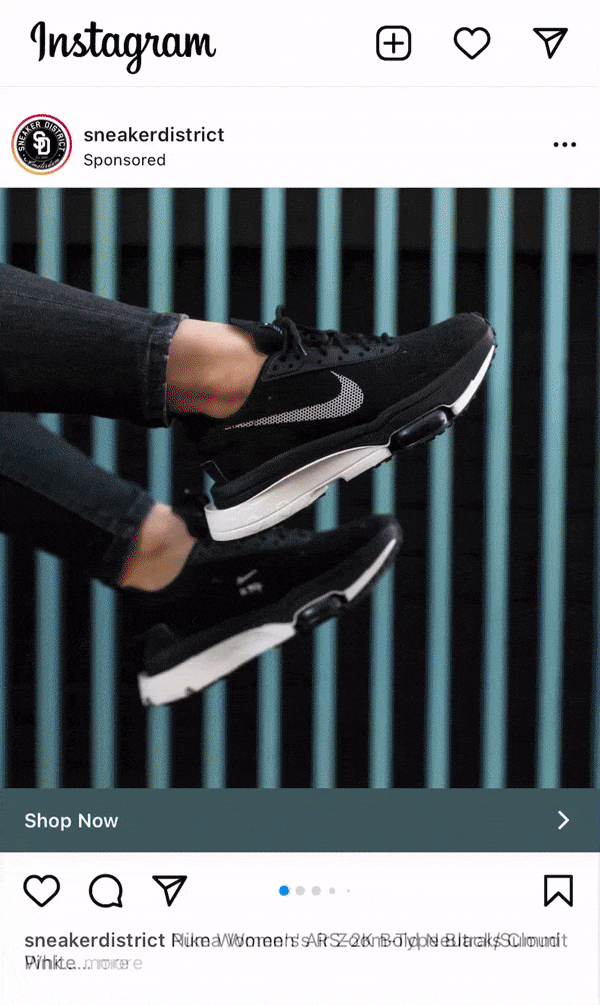
Source: Instagram (@sneakerdistrict)

Collection ads
Collection ads are a combination between carousel ads and shopping ads. Collection ads showcase products directly from your product catalog.
Collection ads are best suited for ecommerce brands, as they allow users to purchase products directly from the ad. When a user clicks on the ad, they're directed to an Instagram Instant Experience Storefront where they can learn more about the product and proceed to purchase.
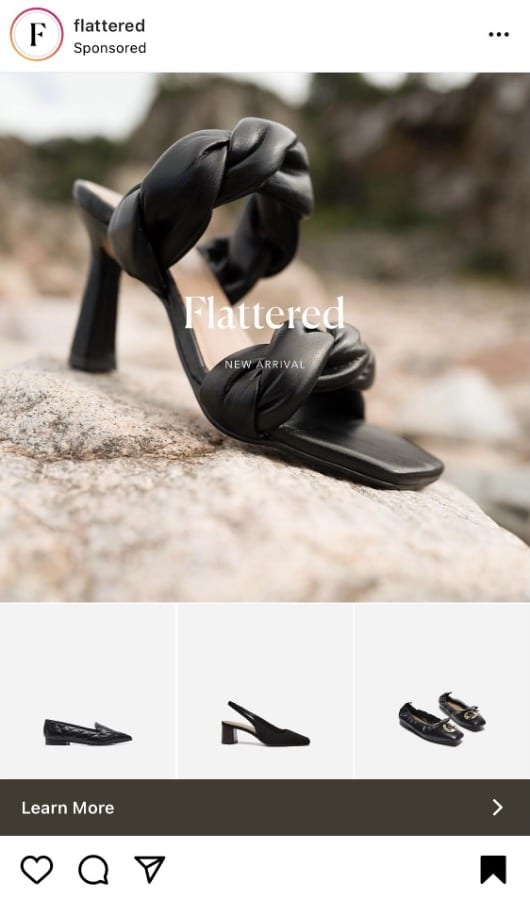
Source: Instagram (@flattered)
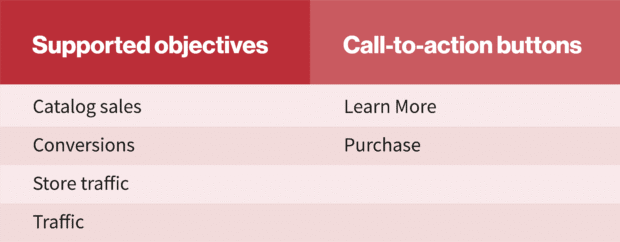
Explore ads
Explore ads appear within the Explore tab, an area of the platform where users discover new content and accounts that are tailored based on their Instagram usage habits. More than 50% of Instagram users access Explore every month, so it's a great place to gain exposure.
Instagram Explore ads do not appear in the Explore grid or the topic channels, but rather are shown after someone clicks on a photo or video from Explore. As the content in users' Explore tabs is constantly changing, Explore ads allow businesses to be shown alongside culturally relevant and trending content.
Explore ads can be both images and videos.
Pro Tip: No need to design brand new assets for Explore ads. You can simply re-use existing assets.
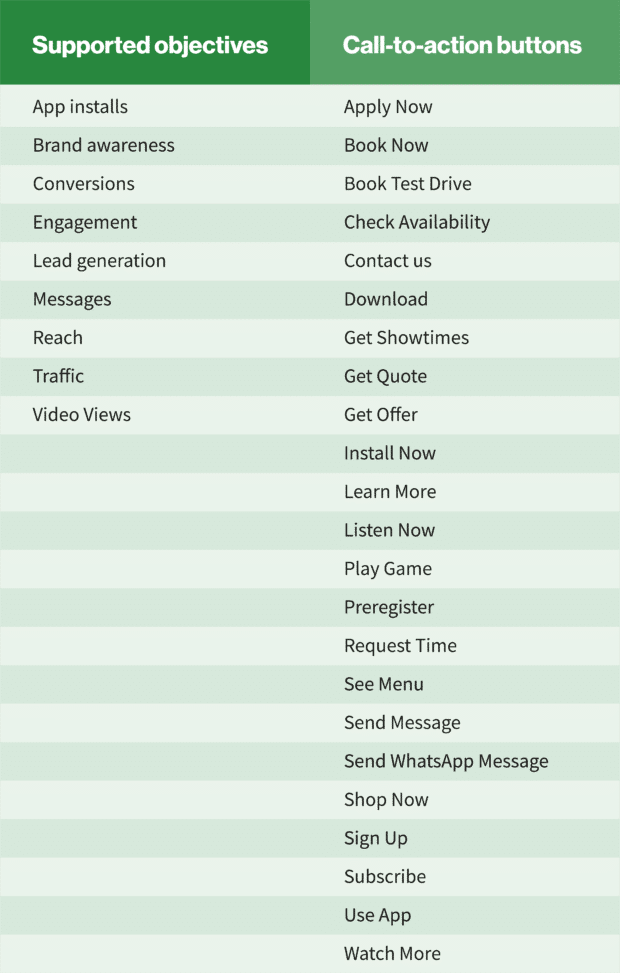
IGTV ads
IGTV ads are video ads that play after a user clicks to watch an IGTV video from their feed. Videos can be up to 15 seconds long, and should be designed for vertical full screen viewing (more IGTV ad specs).
They are shown midroll (in the middle of the video), potentially with the option to skip.
IGTV ads are currently available to users with Instagram Creator accounts in the US, UK, and Australia, with more countries rolling out soon. Creators can opt in to having ads shown in their IGTV videos, and receive 55% of the advertising revenue generated from each view.

Shopping ads
With 130 million users tapping on shopping posts every month, it's no wonder Instagram has been heavily improving its ecommerce features over the last 1-2 years. With Instagram's newest Shopping features, users can now view and purchase products without ever leaving the app (limited to businesses with Instagram Checkout enabled).
Instagram Shopping ads take users directly to a product description page within the Instagram app. They can then purchase through your mobile website.
In order to run Shopping ads, you need to set up your Instagram Shopping catalog.
Pro Tip: Take advantage of Hootsuite's integration with Shopify to access your catalog right from your Hootsuite dashboard.
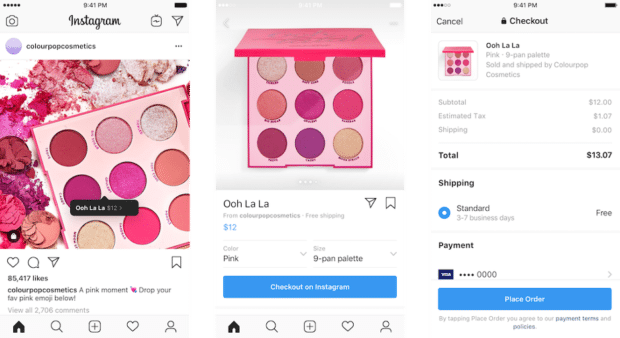
Source: Instagram
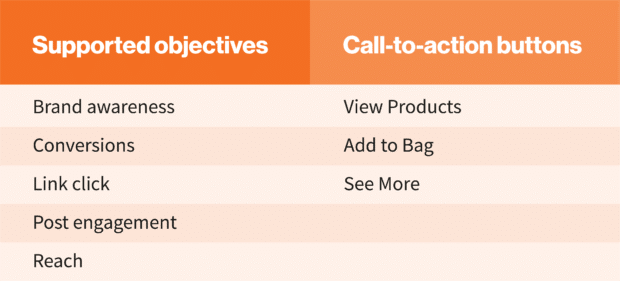
Reels ads
With the successful launch of Reels, Instagram recently announced the ability to advertise within Reels.
Ads are shown in between Reels, with similar specs to Stories ads (full screen vertical videos), and can be up to 30 seconds. They should include sound or music to be well-integrated with organic Reels.

How to choose the best Instagram ad type
With so many different ad types available, it can be overwhelming to select one to use for your campaign. The good news: Ads Manager is well set up for experimentation, which means you can test multiple formats and see which one performs best before running a full campaign.
To narrow down the formats, use these questions to guide you.
1. What is my goal?
With your social media marketing strategy in mind, identify the most important outcome for your Instagram ads campaign. Do you want to:
- Drive traffic to your website?
- Get video views for a new product?
- Increase brand awareness for a new business?
- Drive ecommerce purchases, app installs, or email signups?
After clarifying your goal, you can choose some potential formats based on the supported objectives and call-to-action options for each ad type. For example, Stories, IGTV and Reels ads are better for driving video views, while Shopping and Collection ads will be best for driving ecommerce purchases.
Bonus: Download a free pack of 8 eye-catching Instagram ad templates created by Hootsuite's professional graphic designers. Start stopping thumbs and selling more today.
Download now
2. Who is my target audience?
Depending on who you wish to target with your Instagram ads, some ad types may be better than others.
Think about your audience's habits and behaviors. Do they like watching lots of videos? Are they avid online shoppers? Do they spend more time watching Stories and Reels instead of scrolling through their feed?
Choose ad types with objectives and call-to-actions that match your audience's natural preferences.
3. What has performed best on organic?
Chances are that your organic followers have lots of similarities to the audience you'll be targeting with your Instagram ads. So, look to your organic feed to see what types of content have performed well, and that can give you a good indication of what paid formats might resonate with your audience.
How to advertise on Instagram
There are two routes for creating Instagram ads campaigns: promoting a post and Ads Manager. Promoting an existing post only takes a few taps and can be done right from the Instagram app, but lacks the customization options available in Ads Manager.
Below, we'll walk you through both methods.

Source: Instagram
Instagram advertising method 1: Promoting a post in-app
The easiest way to start advertising on Instagram is to promote one of your existing Instagram posts. This is similar to Facebook's Boost Post option.
If you have a post that's performing well in terms of engagement, promoting it within the app is a quick and easy method to scale up the post's success—and show it to new people who aren't following you yet.
You'll need to have a business or creator account on Instagram to do this. You'll also need to have a Facebook Business Page connected to your Instagram account (here's how to connect your Facebook and Instagram accounts in Facebook Business Manager).
Then, it's as simple as clicking Promote on the post you wish to turn into an ad.

You'll be prompted to choose your preferred audience, destination, budget, and duration for your ad to run.
Finally, tap Create Promotion.
That's it! Your ad will be reviewed and approved by Facebook. Once it goes live, be sure to monitor the results of your ad in the Promotions tab of your Instagram profile.
Instagram advertising method 2: Creating Instagram ads using Facebook Ads Manager (5-step guide)
In order to get the most out of Instagram's extensive ad targeting, creative, and reporting abilities, you can use Facebook Ads Manager to create ad campaigns (remember that Facebook owns Instagram).
Although it requires a bit more work, our 5-step guide will guide you through the process.
Step 1: Choose your objective
To start, go to Ads Manager and click +Create.

First, you'll need to choose your campaign objective from the list below.

Here's a quick breakdown of what each of these objectives aims to achieve.
- Brand awareness: Increase awareness of your business or products among users who haven't heard of you yet.
- Reach: Show your ad to as many people as possible in your target audience.
- Traffic: Drive clicks to your website, app, or any other URL.
- App installs: Get users to download your app.
- Engagement: Increase comments, likes, shares, event responses, and offer claims on your ad.
- Video views: Get video views from users most likely to watch it.
- Lead generation: Gather personal info from interested users (i.e. email signups).
- Messages: Get users to send a message to your brand account.
- Conversions: Drive sales or sign-up conversions on your website or app.
- Catalog sales: Promote sales from your online store catalog.
- Store traffic: Direct users to your brick-and-mortar location.
This video can help identify your objective:
[Instagram Ad Options video]
After selecting your objective, you'll be prompted to name your campaign. Tip: Give it a specific name based on the campaign objective to help you keep track of your campaigns.
Finally, you'll have the option to turn on Campaign Budget Optimization. This option allows Facebook's algorithm to determine how to spend your budget across ad sets. AdEpresso has a full guide about if you should use Campaign Budget Optimization.
Step 2: Choose your budget and schedule
In this step, you'll choose how much you want to spend and how long your campaign will run.

For your budget, you'll have two options:
- Daily budget: Set a maximum daily spend, useful for always-on ads
- Lifetime budget: Set a maximum spend for your whole campaign, useful for ads with a clear end date
Under Ad Scheduling you can choose to run ads continuously (most common), or only at certain times of day (for example, if you're a food delivery company and only want to run ads in the evening when your audience is most likely to place delivery orders).
As you adjust these options, you'll see the Audience Definition and Estimated Daily Results modules in the right-hand column which will give you an idea of expected reach for your chosen budget. Try to choose settings so that your ad set falls in the middle of the green range.
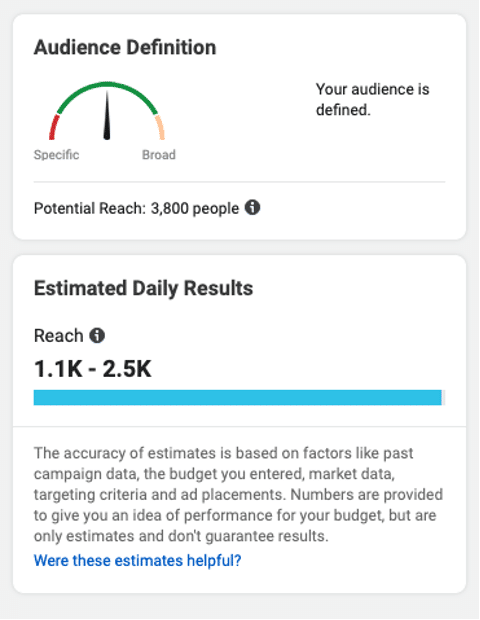
Step 3: Identify your audience
The next step is to define your audience targeting. In this step you can either Create a New Audience or use a Saved Audience.

Saved Audiences are useful if you have your own custom audience data (i.e. past website visitors) or past audiences from previous campaigns that performed well. If not, you can create a new audience based on demographics, interests, and behavioral targeting.
During this step, you can also select Dynamic Creative. If you choose this option, you can upload separate visual assets and headlines, and Facebook will automatically create combinations that are optimized for your target audience.
Step 4: Select your ad placements
In the Placements section, you can decide where your ads will appear.
There are two options:
- Automatic Placements: Ads will be shown to your audience wherever they're likely to perform best.
- Manual Placements: You can choose specifically where your ad will appear (and not appear). If you want to limit your ads to show only on Instagram (not Facebook), you can choose this using Manual Placements.
Here's where you can select your manual placements:

While previewing placements, Ads Manager will display the technical requirements for each one. To ensure your visual assets are optimized for each format, see our guide to social media image sizes.
Step 5: Create your ads
Now it's time to create the actual ad. Start by choosing your Facebook Page and corresponding Instagram Account. Then you can select your preferred ad format.
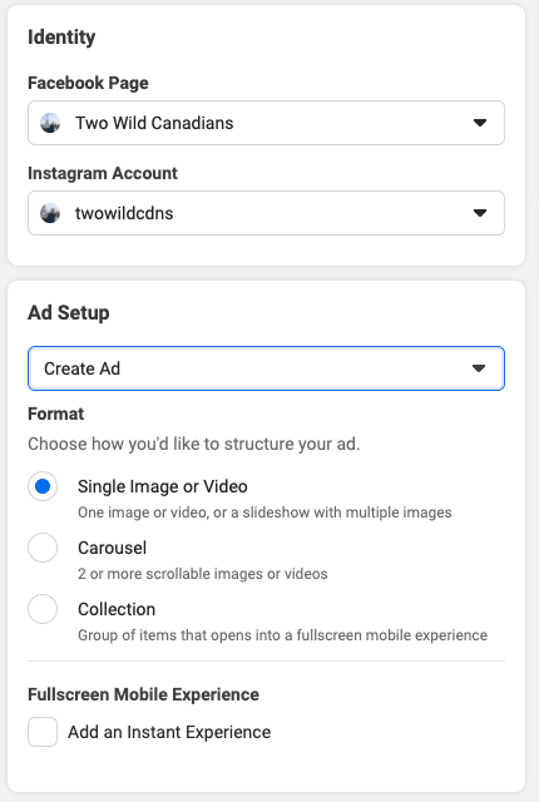
Then, proceed to fill out the rest of the details under Ad Creative:
- Choose your pictures or videos (unless you're using an existing post)
- Input your ad copy
- Select a payment option
- Review your ad
- Click Confirm
At this step you will also choose the call-to-action button and enter the URL where you want to send people who click on your ad.

If you want to track conversions from your ad, it's important to select the Facebook Pixel in the Tracking section. Once connected to your website or app, your Facebook pixel will allow you to see insights about how your audience interacts with your business after clicking on your ad.

When you're ready, click Confirm to launch your Instagram ad.
Best practices for Instagram ads
Now you have everything you need to know about setting up and launching Instagram ads. The next step is designing effective visual assets for your ads.
Here are some tips for how to design attention-grabbing creative for Instagram ads.
Design mobile-first ads
98.8% of users access social media via a mobile device, so it's vital to design your creative for mobile viewing, not desktop.
Here are a few tips to design mobile-first ads:
- When capturing video content, make sure to film in vertical (9×16) as this is easier to crop to 4×5 than from landscape
- Minimize the amount of text in your ads
- If you do add text, choose large font sizes that are easy to read on mobile screens
- Add animations and motion graphics to videos to quickly engage viewers
- Keep videos short (15 seconds or less)
Keep branding and messaging upfront
The first few seconds of your ad will determine whether a viewer will stop scrolling and watch the whole thing. That's why it's important to start your ad with the key message and showcase your branding within the first 3 seconds.
Use sound to delight
40% of users consume social media with sound off. As such, it's important to design your ads for sound-off consumption, and to use sound to delight users who do have sound on. Here's how to do that:
- Use visual elements to tell your story and deliver your key message without sound
- Add captions for any voiceover or scripted audio
- Use text overlay to deliver your key message without sound
Pitch, play, plunge
Facebook recommends designing a combination of creative types that work together to grab attention and reward interest:
- Pitch: Short assets that get the campaign idea across immediately and grab attention
- Play: Assets that allow light exploration and interactivity for interested audiences
- Plunge: Immersive assets that allow people to go in-depth into your campaign idea
Looking for more inspiration? Here are 53 examples of amazing Instagram ads.
Get the most out of your Instagram advertising budget with AdEspresso by Hootsuite. Easily create, manage, and optimize all your Instagram ad campaigns in one place. Try it free today.
Get Started
Easily create, analyze, and schedule Instagram posts and Stories with Hootsuite. Save time and get results.
Try it for Free
How To Use Instagram To Direct People To My Blog
Source: https://blog.hootsuite.com/instagram-ads-guide/
Posted by: vasquezsomforeatty.blogspot.com

0 Response to "How To Use Instagram To Direct People To My Blog"
Post a Comment